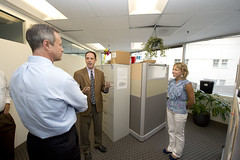Making the switch to green energy can be a little overwhelming, but it can be pretty simple. You can help the environment, regardless of how large-scale the changes you make to your habits are. In the paragraphs that follow, you will find different ways to get into green energy.
Watch watt usage carefully. Use great gadgets such as the Kill-A-Watt or the Watt Minder to find out which fixtures and appliances use up the most energy. Gadgets can be set to give you the energy-usage amounts for hours, months or years. This is helpful in showing you exactly what each appliance costs to run.
If you want to “go green” and do your part to help save the environment, you have a lot of options. You might not have the capacity to invest all of the money to go green immediately, but one can clean furnace filters and adjust the heat at home to be more green. Setting your water heater to 120 F will also be an energy saver. The little things add up.
Use LED lights on the holidays to save electricity. According to research by the United States Two billion KWh if everyone made the change, to be exact! That amount of electricity could power 200,000 homes for an entire year. You could reduce the amount of your own utility bill as well.
Heat your home with biofuels. This type of fuel is usually made with a combination of animal fat, vegetable oil and wood. Typically, if your furnace uses propane, professionals can easily provide changes so you use these fuels. Fuels are anywhere from 20-99 percent biodiesel. Make sure you ask a professional before you attempt to utilize this type of fuel inside your household.
Carpooling is a great way to save energy for transportation needs, even if your trip is to the mall or an after-school event. If you have children organize carpooling with other parents in your neighborhood. Plan your shopping days to correspond with those of your friends. That way you can share a vehicle and the costs of fuel.
Energy Star
Replace aging major appliances with ENERGY STAR appliances. An appliance that has Energy Star uses less energy than an appliance that doesn’t have it. The amount of energy saved depends on the type of appliance. Refrigerators and freezers use 20% less energy, while dishwashers use 40% less. Washing machines use half as much energy as their non-rated counterparts.
Use your microwave whenever you can reasonably use it. Ovens and stoves use lots more energy to prepare food than microwaves. Whenever possible, heat things in the microwave to cut energy costs.
Turn off lights when you exit a room. This is a tried-and-true energy saving trick. You can actually save a lot of energy if you just take the time to turn off all the lights in your house when you aren’t using them. The money that you will save is an added bonus.
A water heater that provides hot water on demand is a wonderful appliance for green energy. Traditional water heaters heat water all day long, even when hot water is not needed; this wastes energy. You’ll get hot water whenever you need it without having to wait for it to heat up. You’ll also save a lot of energy.
It might seem like common sense, but a lot of people don’t turn off their lights, machines and other electronics when they are not being used. This simple action can save anyone a lot of money on monthly bills. Make a conscious effort to ensure your lights and appliances are switched off when not being used.
Despite that it may seem to be, implementing environmentally friendly changes shouldn’t feel overwhelming. As you have seen, switching to green energy can be done quite easily. Do not neglect to put the information in this article to use. In addition to being effortless, you will see many positive results from going green.
Come on toATT Systemsfor reading
